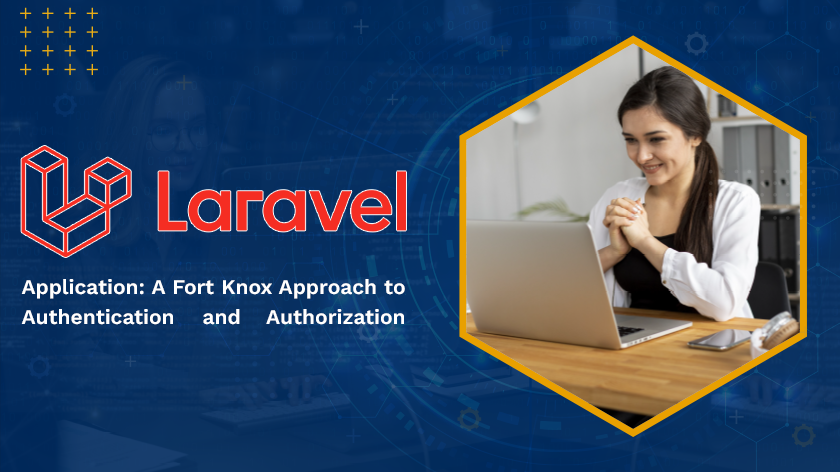In today’s digital landscape, robust security is no longer a luxury – it’s a necessity. This is especially true for web applications built with frameworks like Laravel. Laravel offers a strong foundation for building secure applications, but it’s up to developers to leverage its features and best practices to create an impregnable fortress. This blog delves deep into the world of Laravel security, focusing on authentication, authorization, and the tools that empower you to build applications that inspire confidence.
The Pillars of Security: Authentication and Authorization
- Authentication: is the process of verifying a user’s identity. Is this user who they claim to be? Laravel provides a robust built-in authentication system that allows you to implement features like user registration, login, and password resets.
- Authorization: Once a user is authenticated, authorization determines what actions they can perform within the application. Can this user edit that post? Can they access that sensitive data? Laravel’s authorization features allow you to define clear roles and permissions, ensuring users only access resources they’re authorized to.
Best Practices for Building a Secure Laravel Application
- Always Update: Software vulnerabilities are a constant threat. Keeping Laravel, PHP, and all dependencies up-to-date is crucial. Utilize tools like composer outdated to identify outdated packages and composer update to keep everything patched.
- Embrace HTTPS: Make HTTPS the default communication protocol. This encrypts data in transit, protecting it from prying eyes. Laravel integrates seamlessly with HTTPS, making it a painless switch.
- Sanitize User Input: Never trust user input! Malicious actors can inject code or manipulate data through forms and URLs. Validate all user input using Laravel’s validation tools and escape any data displayed or used in queries to prevent Cross-Site Scripting (XSS) attacks. Consider using Laravel’s built-in helper functions like htmlspecialchars or a package like Laravel Sanitizer for advanced protection.
- Thwart CSRF Attacks: Cross-Site Request Forgery (CSRF) attacks trick users’ browsers into performing unintended actions. Laravel development includes CSRF protection out-of-the-box. Ensure all forms include CSRF tokens to mitigate this risk.
- Embrace Secure Coding Practices: Small mistakes can lead to big vulnerabilities. Adhere to secure coding practices like avoiding raw SQL queries (use Eloquent ORM instead) and following proper password hashing techniques (bcrypt is a good choice).
- Content Security Policy (CSP): A powerful defense against XSS attacks, CSP restricts the sources from which your application can load content (scripts, images, etc.). Laravel supports adding CSP headers to your application’s responses, giving you granular control over content sources.
- Session and Cookie Security: Sessions and cookies are essential for maintaining user state. However, if not configured correctly, they can be exploited. Use Laravel’s session driver options (like database or redis) for secure storage and configure cookie attributes like httpOnly and secure to mitigate risks.
- Limit Login Attempts: Brute-force attacks are a common way to gain unauthorized access. Implement rate limiting for login attempts to deter such attacks. Laravel packages like laravel/throttle can simplify this process.
- Secure File Uploads: File uploads can introduce vulnerabilities if not handled properly. Validate file types and sizes to prevent malicious file uploads. Consider using Laravel’s storage facade with appropriate disk configurations for added security.
- Monitor for Suspicious Activity: Security is an ongoing process. Implement logging and monitoring solutions to identify suspicious activity and potential breaches. Laravel integrates with various logging services for enhanced security monitoring.
Fortify Your Laravel Security Arsenal with Powerful Packages
In addition to Laravel’s built-in features, several third-party packages can supercharge your application’s security posture:
- Laravel Sanitizer: Provides a comprehensive suite of data sanitization tools for robust protection against XSS and other injection attacks.
- Laravel Passport: Simplifies the implementation of OAuth2 authentication, allowing secure API access.
- Laravel Telescope: A debugging and monitoring tool that can be invaluable for identifying security issues.
- Laravel Shift: Offers two-factor authentication (2FA) for an extra layer of login security
DevSecOps Approach:
Integrate security considerations into all stages of the development lifecycle. This involves collaboration between developers, security professionals, and operations teams to ensure security is built-in from the beginning, not bolted on as an afterthought.
Conclusion
Security is not a one-time fix; it’s a continuous journey. By adhering to secure coding practices, leveraging Laravel’s built-in features, and incorporating these best practices and tools, you can build Laravel applications that are fortresses of security, inspiring trust and confidence in your users. Remember, security is an ongoing process. Stay updated on the latest threats and vulnerabilities, and continuously refine your security posture to keep your Laravel applications safe.
As part of XcelTec, I’m here to help you secure your Laravel applications. Our team of experts is dedicated to keeping your applications safe by staying updated on the latest threats and vulnerabilities.
For more details , Visit our website: https://xceltec.com/
 :
https://www.xceltec.com/laravel-development/
:
https://www.xceltec.com/laravel-development/












